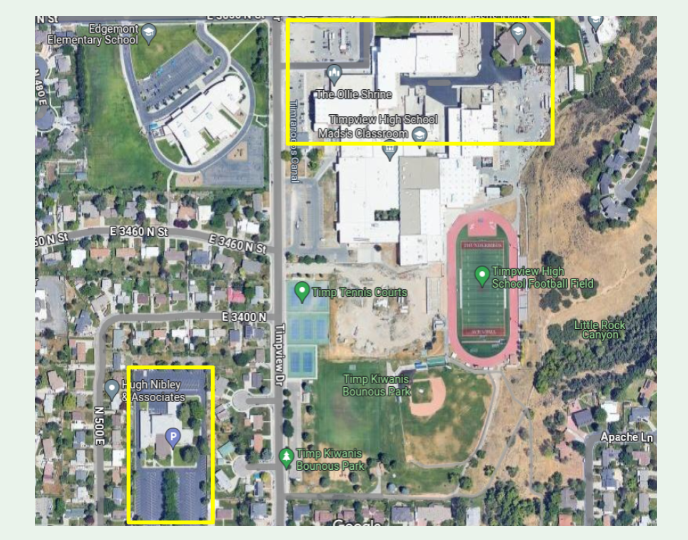For a quick preview of what you need to do, look at the chart at the bottom of the article.
For most people, just getting through High School with good grades, enough credits and passable attendance would be sufficient. However, there are some, maybe even you, who might find High School somewhat boring or tedious. Many seniors will end up taking just a handful of classes in their last year, which is well earned, but what if you could go further? Sure you have AP classes, but they are somewhat limited and sometimes won’t directly transfer to a needed college credit. So what should you do? Don’t worry, it might actually be easier than you think.
UVU and Timpview, along with many other schools and districts, have set up a system which allows high school students to take college classes from the comfort of their own school. This program is known as Distance Learning’s Live Interactive, or DL. These classes are unique in that they are actual college classes that you video call in to, so it’s important to know that they are on an entirely different schedule than Timpview and are taught by actual UVU instructors. While the classes offered are limited, they offer just enough to get your Associate degree when combined with the credit of a few AP/CE classes. UVU only allows students to get a degree in University Studies, with few exceptions, but the credits will transfer to most Utah schools and will still help you in the long run, with the added benefit of being a lot cheaper at just $5 per credit hour. It’s just a good way to fill some time while saving some in the future—plus it doesn’t look too bad on college applications. Something good to remember as well is that even though all DL classes are a semester in length, they count as a year-long class on your high school transcript.
The first thing you will want to think about is whether you want an Associate in Arts (A.A.) degree or an Associate in Science (A.S.) degree. While the requirements are essentially the same, the A.A. degree has a foreign language requirement, which can be good to consider if you have already taken a foreign language and gotten college credit, or if you are planning to, but neither one is necessarily better than the other. The requirements for the A.A. can be found here, while the requirements for the A.S. can be found here.
Now to look at how to get the required credits. If you are an honors student and have taken many AP classes, it shouldn’t be too hard for you to finish your Associate degree. If you aren’t that’s okay, it isn’t over for you. You may also find a different way to go about getting your Associate than what is mentioned here, but this way seems to be one of the more efficient ways to do it. Numbers in parentheses represent the amounts of credits required in each area or offered by each class. Extra credits can count towards required elective credits.
ENGL/ENGH courses (6.0)
Going down the list of requirements, the first one mentioned is the English requirement. Students are required to take ENGL 1010 (3.0) or ENGH 1005 (5.0), and then ENGL 2010 (3.0). The best way to do it would be to get ENGL 1010 and ENGL 2010, both of which are offered through the DL program in succession, both taught from the same teacher with ENGL 1010 the first semester and 2010 the next. Other options include taking AP English Language, which fulfills ENGL 1010 and some elective credit, but doesn’t give you ENGL 2010 so it isn’t as helpful, especially since it takes a full year and at least a 3 on the AP test. AP English Literature also fulfills ENGL 1010 and comes with the added bonus of ENGL 2200 which can be used for the Humanities requirement in the distribution courses (see below), but also doesn’t fulfill ENGL 2010. ENGL 1010 and 2010 are both hard classes, but with each one equalling a year of high school English individually, you could take both of them one year and not have to take English another year. The option to take AP English Language one year and DL ENGL 2010 is also there, but isn’t as efficient.
MAT/MATH/STAT courses (3.0)
Next is Math, where you have the option of taking just one of the following: MAT 1030 (3.0), MAT 1035 (6.0), STAT 1040 (3.0), STAT 1045 (5.0), MATH 1050 (4.0), MATH 1055 (5.0), or MATH 1090 (3.0). This is somewhat of an easy credit to cover as Timpview offers the CE class Quantitative Reasoning 1030 which fulfills MAT 1030 and is just a semester class. On the same level of math, but a bit harder of a course, is CE College Alg/Trig which is a full year class that fulfills MATH 1050 and MATH 1060. If you are past this level of math, taking AP Calculus with an AB score of 4 (BC of 3) or higher will fulfill a higher credit in MATH 1210 in addition to giving elective credit, or taking AP Statistics with a 3 or higher will fulfill STAT 1040.
HIST/POLS courses (3.0)
The history/politics section is quite flexible concerning how it can be fulfilled. You have the option of taking one of the following: HIST 1700 (3.0), HIST 2700 (3.0) and HIST 2710 (3.0), HIST 1740 (3.0), POLS 1000 (3.0), or POLS 1100 (3.0). The shortest option would be to take POLS 1100 through DL, which is just a semester-long class. This requirement can also be fulfilled by taking AP US History and scoring a 3, which fulfills HIST 1700 and gives you HIST 1900 (3.0), or a 4/5, which fulfills HIST 2700 and HIST 2710. You could also take AP US Government and Politics through CE which fulfills POLS 1100 or by taking the AP test and scoring at least a 3 for the same credit. If you took both AP US Government and Politics (or POLS 1100) and AP US History and received the necessary credits, you can have AP US Government and Politics (or POLS 1100) count for this requirement while AP US History can count towards the Social/Behavioral Sciences section of the distribution courses (see below).
PHIL 2050 and HLTH/PES courses (5.0)
This section of courses requires that you take PHIL 2050 (3.0) and HLTH 1100 (2.0) or PES 1097 (2.0). PHIL 2050 can only be fulfilled by taking PHIL 205G through the DL program which is a semester-long course. There is a prerequisite for PHIL 205G, which is to score at least a 29 on the English and Reading section on the ACT, or having completed ENGL 1010 or 101H with a C- or higher, so if you don’t have the ACT score, you have the option of taking English the first semester and PHIL the next. The HLTH/PES requirement unfortunately cannot be fulfilled through DL, CE, or AP classes, so you will need to pay to take the actual college course through UVU, BYU or MTECH, each one costing around $500. This is something to keep in mind, but remember that having to pay for one college class and completing your associate in high school is still a lot cheaper than paying two years of college tuition. The silver lining to this is that if you transfer your completed health credit to Timpview, you will not have to take a high school health class. For UVU’s suggested health course options, click here.
Distribution courses (18.0)
The remaining required courses are not as specific with which class you have take (still minimum of a 1000 level course), but requires Biology (3.0), Physical Science (3.0), Additional Biology or Physical Science (3.0), Humanities Distribution (3.0), Fine Arts Distribution (3.0), and Social/Behavioral Science (3.0). Biology can be fulfilled easiest through AP Biology, which can yield up to 9 credits if taken through CE while also taking the AP test (and scoring a 3 or higher). Doing both CE and the AP test is smart as it also fulfills the Additional Biology or Physical Science requirement and gives you some elective credit. Physical Science can be fulfilled through CE Chemistry, AP Chemistry, or AP Physics with a score of a 3 or higher on the AP tests for the latter two options. A quicker way might be to take ASTR 1040—astronomy (3.0), GEO 1010—geology (3.0), or METO 1010—meteorology (3.0) through DL which are all semester-long classes and fairly light as they’re all introductory courses.
Humanities isn’t too bad of a requirement to fulfill and there are a lot of methods to do it. By taking the AP English Literature test (with at least a 3) you can get ENGL 2200 which fulfills the requirement, or by taking AP Chinese, AP French, AP/CE German, or AP Spanish with at least a 3 on the AP tests. These are legitimate methods, but the credits would be better used elsewhere, so the best option is to take either HUM 1010—humanities or COMM 1500—mass communication through DL. The Fine Arts is another fairly easy one to cover, and can be done through AP Art History (score of 3, 4, or 5), AP Music Theory (score of 3, 4, or 5), or DL classes in Art 1010—visual arts, or MUSC 1030—popular music. The last area is Social/Behavioral Science which has a lot of options for fulfillment. The easiest method would be to take CE Financial Literacy which is already required to High School graduation and fulfills the distribution through FIN 1060. Other ways to do it could include CE Economics for ECON 1010, AP/CE Government and Politics with a 3, 4, or 5 or POLS 1100 through DL, AP Psychology or PSY 1010 through DL, AP US History with a 4 or 5 for HIST 2700 and HIST 2710, or AP World History with a 3, 4, or 5 for HIST 1500.
Elective Courses (25.0)
This is the only section that differs between AA and AS degrees, but not by much. If you are getting an AA degree, 8.0 of the 25.0 credits required have to come from a foreign language credit (other than English) to include 1010 and 1020 levels. Just taking an AP test for any foreign language will fulfill this requirement with a score of at least 3, which is probably the best way to do it as the few languages that offer CE credit will only give you 3 or 4 credits. If you are not planning on taking a foreign language or going that far in a foreign language, I would stick with an AS degree. Required electives can be easy to forget about sometimes but are fairly easy to obtain. If you are doing any elective class just for Timpview graduation requirements, there is a good chance that there is CE credit offered so always check and look for that.
Well I’ve just bombarded you with a ton of information and hopefully it all made sense. I’ve listed all of the options, so let’s quickly organize them into the most efficient way to get your associate degree by the end of high school:
|
|
|
|
|
|
|
|
|
|
|
|
- CE Elective credits, AP credits from tests, or even extra DL classes – 23 credits AS, 15 credits AA (2 extra credits transfer from Biology)
*Replacing DL ENGL 1010 and DL HUM 1010/COMM 1050 with AP English Literature would fulfill the same credits for the same combined amount of time (2 semesters) if you get at least a 3 on the AP test.
Highlighted classes are classes I have taken and can provide personal information on.
Of course, getting your associate degree in high school won’t be easy, but it doesn’t have to be complicated too. DL classes are college-level, so I would strongly suggest you only do 3 a semester maximum. Make sure to think all of this over; DL and CE class grades go on your college transcripts, and by taking AP tests you run the risk of not passing, wasting a year (in terms of college credit), and not getting the college credit you need. Many of the classes have prerequisites to consider as well. If you have any questions, feel free to contact me through my email [email protected], though I would encourage you to also contact Lisa Pulver who is over CE and DL programs at Timpview ([email protected]) and Matt Gardner who is Timpview’s CE advisor at UVU ([email protected]) if you are even the least bit interested. To get the information from this article, click the links throughout the article and below and just know that the information is subject to change.
Information on individual DL courses (and all other 2020-2021 Timpview courses)
UVU General Education Academic Planner
Timpview’s page for Distance Learning
Timpview’s page for Concurrent Enrollment








